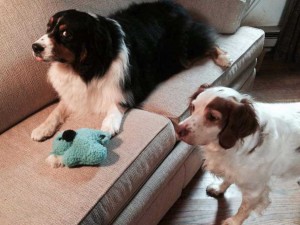Too Bad! Why I Use Time Outs
There are a few topics in the dog training world that can rouse people’s cortisol levels to an extraordinary level. Time outs are one of those topics. There was a video making the rounds a while back about time outs for kids being “bad”, being widely shared by some trainers as “proof” that we should not implement these for dogs either “because they can damage the psyche”. The problem with that train of thought is that the video wasn’t talking about appropriately implemented time outs (for either species!). I don’t have children so I will not be offering any opinions on the child care part of this equation. But I will happily explain how time outs can assist quite nicely with dog behavior modification efforts with zero fall out with *appropriate* use. But before I do so, I would also like to briefly mention a lovely article about the top 10 behaviors of expert animal trainers. One mention was minimizing the use of a time out. I quite agree with that but I also want to note that this lovely article was written primarily about *wild* animal trainers. The relationship between the wild animal and the trainer is very different from your relationship with the dog that you live with. So while minimizing the use of time outs should certainly be the goal, equating the use of a Time Out with a dog in certain situations with the use of such with wild animals is not an equal comparison. Now that I have hopefully prevented this article being tossed at me as proof of how horrible I am, let’s move on.
Let’s define appropriate usage. With my own clients, there are many situations that may warrant time out usage. But each implementation is individual to the situation. There is no one size fits all and sometimes with each situation, judgment calls need made by the human part of the equation to determine what is best each time. My definition of a time out is a withdrawal of attention and/or privileges. The privilege that is lost may be the ability to move around freely (and wreak havoc!) or it may be just not engaging with a favorite human for a brief (30 seconds to 2 minutes!) moment in time. A time out is NEVER suggested for a dog that would feel traumatized by either of these things. Such a dog wouldn’t need a time out so it’s a moot point at best. The dogs that need a time out are typically adolescents testing boundaries or adult dogs who were never taught impulse control as a puppy. Or even canine bullies (the action, not the breed) in a multiple dog household.
One of my frequent usages is with puppies who are quite literally, running amok. They are lacking in impulse control and their inappropriate choices have been inadvertently reinforced by negative attention (no, stop, don’t do that, push away, etc.). What happens when you reinforce a behavior, even with negative attention? The behavior is maintained or even increased. Yep, you created a monster. The puppy has discovered the battleground game and is having a great time with this. The owners, not so much. They are exhausted and need a way to teach consequences for the puppy’s actions without hurting or scaring the puppy.
This also applies to older dogs that were never taught these consequences to their choices as puppies. The puppy/dog wears a lightweight leash and there are also lightweight leashes placed around various pieces of sturdy furniture so that the owner needn’t walk more than 5 or 6’ to implement a time out. Taking too long to provide a consequence means that you lose the message. The time frame between the verbal marking of the moment of the poor choice with the time out word or phrase to the actual time out, should be mere seconds.
Of course, time outs are not limited to tethering. Some issues are better addressed by walking away or walking into the nearest room that has a door, such as a powder room or even behind a gate (typically you, not the dog, except puppies!) But again, timing is everything. The time out word marks the moment, just as a yes or a clicker or even a good boy/girl marks the moment of an appropriate choice. And we know that the reward must immediately follow the marker in order to be effective, right? Same theory applies here. The consequence must immediately follow the marker. My time out marker is said in a sing song voice (Too Bad!) for all the world sounding like “you screwed up”. There should never be anger in a time out marker.
If attention is the intent, withdrawing said attention is a need. Even turning your back to a dog who is inappropriately attempting attention seeking is a time out. Would you call a dog traumatized because you turned your back briefly? Exactly. Often turning away isn’t enough of a withdrawal of attention for many dogs. Hence, we have the option to exit the room/situation.
Now I know that many trainers will say to teach the puppy/dog in question what to do instead of what they are doing that causes annoyance. Of course, that is also happening. Or it certainly should be. But that is simply not enough in many cases, especially where the poor choices have resulted in so much attention that it’s pretty much game on every day. If a dog is rewarded for doing the right thing after ALWAYS starting that sequence of behavior with a poor choice, you do see the problem here, right? Behavior chains can be lovely things but they can also be nightmares to behold. Modifying behavior successfully is always a matter of a bit of detective work in finding what works for THAT dog in THAT situation, without causing emotional or physical trauma on both sides of the equation. Properly done, time outs along *with* capturing appropriate choices, provide all of the relevant information to the dog so that forward movement can be obtained with minimum stress. Win/win.
Posted in: Projects
Leave a Comment (2) →


